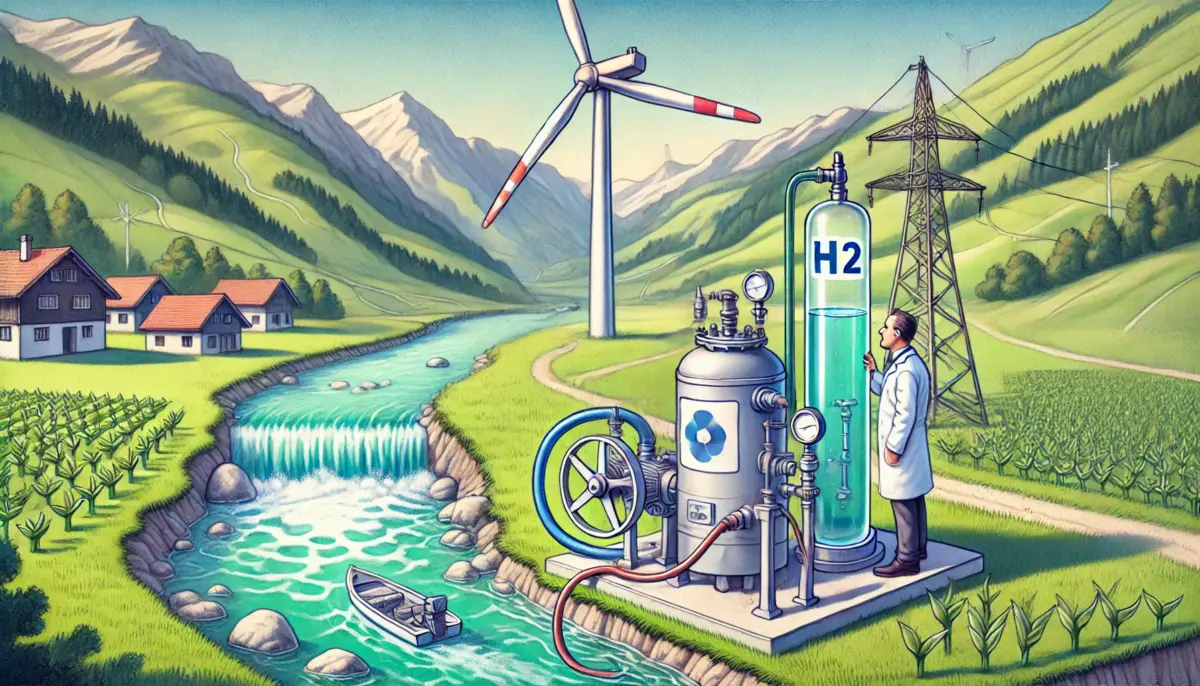Sign up for our newsletter!
Your data will be handled in compliance with our privacy policy.
Your data will be handled in compliance with our privacy policy.

Discover how Smoltek’s innovative Porous Transport Electrode (PTE) technology stands up to expert scrutiny. Learn about its impressive performance, and why it’s poised to transform PEM electrolyzers. Get the inside scoop on what this means for Smoltek’s future in the green hydrogen market.
Smoltek has taken a strategic step by inviting Dr. Felix N. Büchi, an independent expert in proton exchange membrane (PEM) technologies, to review Smoltek Hydrogen’s Porous Transport Electrode (PTE) technology. In his evaluation, Dr. Büchi recognizes that ”Smoltek electrodes are a very interesting development for the production of low iridium loading electrodes for PEM electrolyzers.” His comprehensive analysis provides valuable insights for further development. Let’s delve into the details of this exciting evaluation and what it means for Smoltek’s future.

You might be wondering who Dr. Felix N. Büchi is and why his opinion carries such weight. As a prominent Swiss scientist specializing in electrochemical energy conversion and storage, Dr. Büchi is at the forefront of fuel cell technology and electrolyzer development.
As Group Head at the Electrochemistry Laboratory at Switzerland’s prestigious Paul Scherrer Institute (PSI), Dr. Büchi focuses on advancing PEM fuel cells and PEM electrolyzers. His expertise is particularly relevant in characterizing and evaluating porous materials for these applications. His pioneering work with X‑ray imaging under operando conditions has revolutionized the understanding of PEM devices’ mass transport and two-phase flow, leading to approximately 50 dedicated papers since 2009.
With a Ph.D. in Fundamental Electrochemistry from the University of Bern and experience from respected institutions like Texas A&M University, Dr. Büchi is recognized globally for his expertise in polymer electrolytes and electrochemical systems.
Dr. Büchi’s assignment was to evaluate Smoltek Hydrogen’s PTE technology. The resulting document, ”The Büchi Report,” provides an in-depth analysis of the technology’s performance and areas for further optimization.
While the full report contains confidential business information, we’re excited to share key highlights with you. These insights demonstrate how Smoltek’s innovation addresses a critical challenge in the PEM electrolyzer industry – the pressing issue of iridium scarcity that threatens to constrain the industry’s growth.
The numbers tell a strong story: The green hydrogen industry will need 30 tons of iridium annually by 2030, while global production capacity is limited to 9 tons annually. With current iridium prices around 150,000 EUR per kilogram, and market analysts projecting prices to reach 700,000 EUR per kilogram by 2030 due to the supply-demand gap, reducing iridium usage becomes crucial for commercial viability. With our technology, iridium consumption is reduced by 95% compared to current levels.
The reduction of iridium load is possible because of our fundamental rethinking of electrode design. To understand our approach, let’s look at the basic structure of a PEM electrolyzer.
It has two electrodes separated by a thin proton exchange membrane (PEM). At one electrode, called the anode, the surface of the titanium porous transport layer (PTL) pressed against the membrane must be coated with iridium. This extremely rare and expensive metal acts as a catalyst to make the reaction happen. This is where Smoltek’s breakthrough innovation comes in.
Our approach revolves around the innovative use of carbon nanofibers (CNF): We grow these CNFs directly on the titanium surface that faces the membrane, creating a structure that multiplies the surface area by 10–30 times. This greatly enlarged surface area means we can spread out and utilize the iridium catalyst much more efficiently – achieving the same performance with much less of the precious metal.
We call the complete assembly – a titanium PTL with iridium coated CNFs on the membrane-facing surface – a Porous Transport Electrode (PTE). This integrated approach represents a fundamental shift from traditional electrode design, combining structural support, increased surface area, and catalyst functionality in a single component. The technology is strongly protected by patents covering key aspects of the design and manufacturing process..
The effectiveness of this approach has been proven in extensive testing. By applying iridium to our CNF-enhanced PTL using a proprietary process, we’ve achieved remarkable results in reducing iridium loading.
Dr. Büchi evaluated our electrodes with 0.2 mg/cm2 of iridium, which already represents a significant reduction from the up to 2 mg/cm2 used in traditional electrodes.
Building on these promising results, our development work continues toward our target of 0.1 mg/cm2, which would mark a breakthrough in iridium utilization efficiency.
The carbon nanofibers in Smoltek’s design require protection against the harsh, highly oxidizing environment at the anode. To prevent degradation, we apply a protective layer of platinum. Dr. Büchi confirms that this protective layer is relevant for our approach.
Ensuring long-term durability remains a top priority. We’re committed to extensive testing under real-world operating conditions to verify that our efforts never compromise the reliability and performance of our electrodes.
Dr. Büchi’s analysis highlights several key strengths of our approach:
The examined iridium loading (0.2 mg/cm2) demonstrates significant economic potential, particularly considering iridium’s high cost and limited availability.
The CNF-enhanced surface area, which is 10–30 times larger than the original PTL membrane-facing surface, enables more efficient catalyst utilization – a key factor in achieving high performance with reduced material use.
Initial testing confirms remarkable initial results, achieving 2.5 A/cm² at 2V at 80 °C – a performance that, in his words, ”matches the state of the art.”
This shows that our unique approach to electrode design can deliver industry-competitive performance while using significantly less iridium.
In his overall assessment Dr Büchi concludes: “Smoltek’s electrodes are a very interesting development for the production of low iridium loading electrodes for PEM electrolyzers.” According to Dr. Büchi, the technology makes it possible to create anodes with a greatly enlarged surface area while using minimal amounts of iridium catalyst, all integrated directly onto the porous transport layer.
His evaluation included both examining the electrode by itself (“ex-situ characterization”) and testing it under real operating conditions.
He notes that “the ex-situ characterization of the electrodes shows that the aspired goals with high surface and low homogeneous specific iridium loading can be realized.”
While these initial evaluations are promising, the most compelling results come from real-world testing. Dr. Büchi examined the electrode’s performance when integrated into a complete electrolyzer cell, where it worked together with a membrane and cathode to produce hydrogen under actual operating conditions.
Earlier this year, Smoltek achieved a significant milestone by successfully operating a PEM electrolyzer cell for 1,000 hours using only 0.2 mg/cm2 of iridium catalyst. Dr. Büchi’s thorough analysis of this durability test has now provided valuable insights into both the technology’s capabilities and its path forward.
In his assessment, he notes: “The characterization in PEM electrolysis cells shows that the Smoltek electrodes give a very good performance at begin of life. Though, at the time, a deactivation occurs in the first 10 hours of operation. There are hypotheses on the mechanism, but none is proven.”
Let’s break this down: The initial performance was excellent – exactly what we were looking for. However, during the first 10 hours of operation, we observed a decrease in performance. While the electrode continued to produce the desired hydrogen output throughout the remaining 990 hours, it required slightly more electrical power than optimal.
The cause of this performance drop had puzzled our team until Dr. Büchi’s evaluation. His insights provided a likely explanation for the reduced membrane contact area and, more importantly, offered clear pathways for improvement. Based on his recommendations, we’re implementing several enhancements for our next durability test:
With these improvements in place, we’re confident in our path forward. Our goal remains clear: demonstrating that our PTE technology can match industry-standard performance while using significantly less iridium.
Dr. Büchi’s report reinforces our confidence in the fundamental approach of our PTE technology. His independent assessment confirms that our innovative method for reducing iridium loading while maintaining high performance addresses a critical industry challenge. The report also provides valuable guidance for our continued development work.
The path to commercialization in deep tech often requires careful attention to detail and systematic evaluation. Each milestone we achieve – including this thorough external review – brings us closer to our goal of enabling more efficient and sustainable hydrogen production. We’re particularly encouraged by Dr. Büchi’s confirmation that our approach to reducing iridium usage shows promise, as this addresses one of the most significant barriers to scaling up green hydrogen production.
As shareholders and stakeholders in Smoltek’s journey, your perspective is invaluable:
Join the discussion in the comments section of our LinkedIn post about this article. Your insights help shape our communication strategy and reinforce the value of patience in developing transformative technologies. Together, we’re building a foundation for a more sustainable future.
Your data will be handled in compliance with our privacy policy.